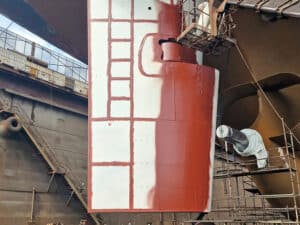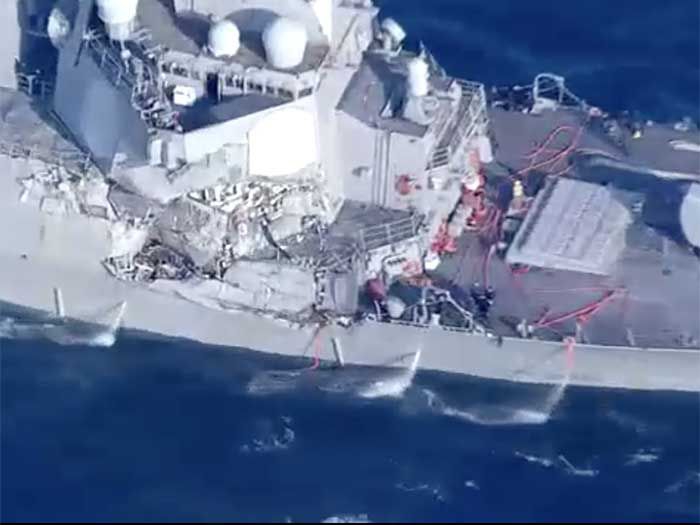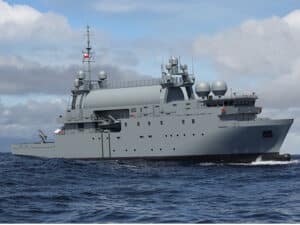
Report slams Surface Navy culture, leadership
Written by Nick Blenkey
A Report on the Fighting Culture of the United States Navy’s Surface Fleet,
A report commissioned by four members of Congress in the wake of several high-profile Navy losses of lives and warships makes disturbing reading. Entitled “A Report on the Fighting Culture of the United States Navy’s Surface Fleet,” it was commissioned by, Sen. Tom Cotton (R-Ark.) along with Representatives Jim Banks (R-Ind.), Dan Crenshaw (R-Texas), and Mike Gallagher (R-Wis.).
“The findings of this report are very concerning,” said Cotton. “Our sailors are too often deprived of the training and leadership they need to fight and win at sea.”
“This report doesn’t mince words,” said Banks. “At a time when the Navy’s readiness is more critical than ever before, this report depicts a Navy leadership that’s distracted from the number one threat to American national security: The Chinese Communist Party.”
“The findings clearly indicate that our sailors are not receiving the training they need to perform the essential functions of the Navy: to find and sink enemy fleets and ensure freedom of navigations,” said Crenshaw.
“As we’ve seen from a tragic string of accidents in recent years, it is clear that all is not well in our surface Navy,” said Gallagher.
STRING OF INCIDENTS
The review began after the total loss of the USS Bonhomme Richard pier-side one year ago. Other mishaps include the collision of the USS John McCain in the South China Sea, the collision of the USS Fitzgerald off the coast of Japan, and the surrender of two small Navy craft to the Iranian Revolutionary Guard Corps Navy in the Arabian Gulf.

Two retired flag officers, Lt. Gen. Robert E. Schmidle, United States Marine Corps, and Rear Adm. Mark Montgomery, United States Navy, led an interview team consisting of Congressional staff, military veterans, and outside experts to produce the report. This team conducted interviews between September 2020 and March 2021, along with weekly meetings to discuss findings and validate that the interview process remained focused and nonpartisan.
A total of 77 exhaustive and intensive interviews were conducted with sailors of all walks of naval life—active duty and reserve, officer and enlisted, retired and separated—producing over 100 hours of transcripts. All interviews were conducted in-person or by phone/telecom and recorded to ensure accuracy.
Subjects were identified by a blind referral process, with a preference for officers with surface warfare experience and significant time at sea. 78% of interviewees were active duty, both current and separated/retired, with approximately 20% serving as reservists. The sample selection was overwhelmingly officers between the grades of Lieutenant (O-3) and Captain (O-6). Of the 77 interviewed, 67 were male and 10 were female.
ISSUES
Specific issues raised by the interviews:
Insufficient leadership focus on warfighting. Perhaps the most concerning comment and consistent observation amongst interviewees was that the service does not promote or advance surface ship warfighting in a meaningful way. Finding and sinking enemy fleets should be the principal purpose of a Navy. But many sailors found their leadership distracted, captive to bureaucratic excess, and rewarded for the successful execution of administrative functions rather than their skills as a warfighter. There was considerable apprehension that the surface warfare community in particular lost its fighting edge in the years following the end of the Cold War. With China building and operating a competitive fleet, the lack of proper attention on warfighting was of deep concern to many interviewees.
A dominant and paralyzing zero-defect mentality. A prevalent theme emerged over the course of the interview process: near universal disdain for the so-called “one mistake Navy,” the practice of treating certain errors with career termination and offering no opportunity for recovery. A former senior leader framed this problem using an evocative historical analogy, suggesting that none of the four key Admirals who led victorious fleets in World War II would have made it to the rank of Captain in today’s Navy. The general unwillingness to rehabilitate one-off mistakes, the disinclination to weigh errors against the totality of a naval career, and the practice of discipline-by-paperwork were broadly understood to be a drain on the Navy’s retention efforts.
Under-investment in surface warfare officer training. The investment in surface warfare officer training pales in comparison to investments in aviation and submarine communities. Compounding its under-investment problem, the surface Navy has “re-imagined” its officer training programs multiple times in the past 20 years, often seeking efficiencies (i.e. even smaller investments) and leaving the commanding officers with inconsistent, often ill-prepared wardrooms.
Poorly resourced and executed surface ship maintenance programs. Nearly every interviewee had a story of a cancelled, delayed, or drastically reduced major maintenance availability. Often this was identified as a problem driven by senior civilian leadership and combatant commanders who consistently accepted the “maintenance risk” to squeeze an extra month or two out of a deployment. But this was also seen as a failure in manning and training the surface community to develop and assess maintenance work packages. Finally, there was an overwhelming perception that the surface Navy is the “billpayer” as aviation and submarine nuclear maintenance packages were seen as too risky to underfund. The cumulative effect of this underfunding and poor execution has left the surface warships less modernized and less ready for combat operations.
Expanding culture of micromanagement. Concerns of micromanagement within the surface warfare community are alarming. Sailors’ concerns were two-fold. The first is that technology has empowered admirals and commodores to exercise greater, arguably unhealthy, levels of control over ship captains. The second was that this control drives a level of toxicity and lack of accountability and initiative in the Navy’s warfighting command hierarchy. Given the increasing likelihood that naval commands may be isolated or cut off from communications in a high-end fight, creating undue dependence on higher headquarters for day-to-day direction could negatively impact future naval combat operations.
Corrosive over-responsiveness to media culture. Sailors believe that Navy leaders are excessively reactive to an unyielding U.S. news cycle, and are unable to distinguish between stories that demand a response and stories that do not. A pervasive sentiment is that Navy leaders have subverted the responsibilities of the chain of command to the pages of Military.com or the Military Times, and make punitive decisions based on negative news reports rather than the service’s own standards of discipline.
MUST READING
The full report is must reading. To give you some of its flavor, here is a sampling of some quotes from the interviews:
“[We are] probably accelerating those cultural tendencies that are creating officers that are less confident and less competent and less comfortable exercising command.
“Sometimes I think we care more about whether we have enough diversity officers than if we’ll survive a fight with the Chinese navy.”
“No one would ever expect an aviator to land a plane on a flight deck or a submarine officer to dive the boat after a few weeks reading 23 Compact Discs (CDs), but the Navy did exactly that …”
“I’ve never heard anyone in any [congressional] testimony that I can think of that talks about actually winning …”




